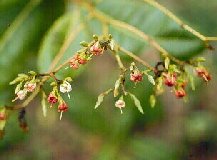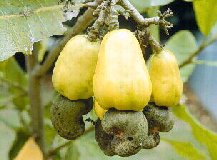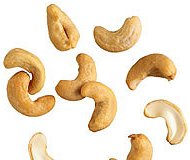Cashew Nut
http://www.100md.com
《e Natural Health Center》
 |
 |
 |
 |
Nuts and Seeds
Cashew Nut
Latin:
Anacardium occidentale
Origin:
The seed of the tree Anacardium occidentale L., of the family Anacardiacae (Cashew). The cashew is native to northeast Brazil and, in the 16th Century, Portuguese traders introduced it to Mozambique and coastal India, but only as a soil retainer to stop erosion on the coasts. It flourished and ran wild and formed extensive forests in these locations and on nearby islands, and eventually it also became dispersed in East Africa and throughout the tropical lowlands of northern South America, Central America and the West Indies. It has been more or less casually planted in all warm regions.
, 百拇医药
The cashew tree is generally bushy, low-branched and spreading. It grows up to 15 meters in height and has a thick and tortuous trunk and branches so winding that they frequently reach the ground. It is an easily grown evergreen relative of the mango, poison sumac and poison ivy. Very sensitive to cold, especially in warm winters followed by a freeze. Its leaves, mainly in terminal clusters, are oblong-oval or obovate, 10-20 cm long and 5-10 cm wide, and leathery. Yellowish-pink, 5-petalled flowers are borne in 15-25 cm terminal panicles of mixed male, female and bisexual.
, 百拇医药
The true fruit of the tree is the cashew nut resembling a miniature boxing-glove; consisting of a double shell containing a caustic phenolic resin in honeycomb-like cells, enclosing the edible kidney-shaped kernel. An interesting feature of the cashew is that the nut develops first and when it is full-grown but not yet ripe, its peduncle or, more technically, receptacle, fills out, becomes plump, fleshy, pear-shaped or rhomboid-to-ovate, 5-11.25 cm in length, with waxy, yellow, red, or red-and-yellow skin and spongy, fibrous, very juicy, astringent, acid to subacid, yellow pulp. Thus is formed the conspicuous, so-called cashew apple.
, 百拇医药
The production and processing of cashew nuts are complex and difficult problems. Because of the great handicap of the toxic shell oil, Latin Americans and West Indians over the years have been most enthusiastic about the succulent cashew apple and have generally thrown the nut away or processed it crudely on a limited scale, except in Brazil, where there is a highly developed cashew nut processing industry, especially in Ceara. In Mozambique, also, the apple reigned supreme for decades. Attention then focused on the nut, but, in 1972, the industrial potential of the juice and sirup from the estimated 2 million tons of surplus cashew apples was being investigated. In India, on the other hand, vast tonnages of cashew apples have largely gone to waste while that country pioneered in the utilization and promotion of the nut.
, 百拇医药
The apple and nut fall together when both are ripe and, in commercial nut plantations, it is most practical to twist off the nut and leave the apple on the ground for later grazing by cattle or pigs. But, where labor costs are very low, the apples may be gathered up and taken to markets or processing plants. In Goa, India, the apples are still trampled by foot to extract the juice for the locally famous distilled liquor, feni. In Brazil, great heaps are displayed by fruit vendors, and the juice is used as a fresh beverage and for wine.
, 百拇医药
In the field, the fruits are picked up and chewed for refreshment, the juice swallowed, and the fibrous residue discarded. In the home and, in a limited way for commercial purposes, the cashew apples are preserved in sirup in glass jars. Fresh apples are highly perishable. Various species of yeast and fungi cause spoilage after the first day at room temperature.
Food technologists in India have found that good condition can be maintained for 5 weeks at 0° C to 1.67° C and relative humidity of 85 percent to 90 percent. Inasmuch as the juice is astringent and somewhat acrid due to 35 percent tannin content (in the red: less in the yellow) and 3 percent of an oily substance, the fruit is pressure-steamed for 5 to 15 minutes before candying or making into jam or chutney or extracting the juice for carbonated beverages, sirup or wine. Efforts are made to retain as much as possible of the ascorbic acid.
, 百拇医药
Food technologists in Costa Rica recently worked out an improved process for producing the locally popular candied, sun-dried cashew apples. Failure to remove the tannin from the juice may account for the nutritional deficiency in heavy imbibers of cashew apple wine in Mozambique, for tannin prevents the body's full assimilation of protein.
Also called Cashew, Cashew Apple, or Cashew Fruit.
Properties:
, 百拇医药
Sweet in flavor, mild in nature.
Functions:
Pushes down qi (energy), quenches chronic thirst.
Applications:
Cashew nut is used for cough, hiccups, excessive thirst, depression.
Dosage and Administration:
More than half of all cashew nuts are eaten as snacks, either by themselves or in mixed nuts. Smaller cashews and broken pieces are often used for baking and desserts.
, 百拇医药
Cashers are often added to Indian cooking, such as curries and rice dishes. When adding cashews to hot food, they should be added just before serving since they soften quickly when cooked.
Cashew nuts spoil quickly at room temperature and should be refrigerated. If refrigerated in a tightly sealed container, they will keep for six months or up to a year if frozen.
Cashew nuts are available year-round. They are sold "raw" and roasted, salted and unsalted, and in bulk or vacuum-sealed jars or cans.
, http://www.100md.com
Cautions on Use:
The nut is not edible or safe when raw. Touching an uncooked nut can cause skin eruptions and the smoke given off by roasting is itself an irritant and poisonous.
Alpha-linolenic acid is a fatty acid found in many foods. Most, but not all, studies have found that high dietary or blood levels of alpha-linolenic acid correlate with an increased risk of prostate cancer. Concentrations of alpha-linolenic acid are high in cashews and other nuts such as almonds, Brazil nuts, flaxseed, hazelnuts, macadamia nuts, peanuts, pecans, pine nuts, pistachios, and walnuts.
, 百拇医药
Reference Materials:
Toxic or Side Effects:
Modern Researches:
The cashew tree produces many resources and products. The bark and leaves of the tree are used medicinally, the cashew nut has international appeal and market value, and even the shell around the nut is used medicinally.
Cashew apple contains ascorbic-acid, beta-carotene, calcium, hexanal, iron, leucocyanidin, leucopelargonidine, limonene, niacin, phosphorus, protein, riboflavin, salicylic-acid, thiamin, trans-hex-2-enal.
, 百拇医药
Then there is the "cashew fruit". The cashew fruit is very peculiar as it really isn't a fruit at all. Cashew Fruit is actually a swollen peduncle that grows behind the real fruit which yields the cashew nut. This large pulpy and juicy part is a pseudo-fruit with a fine sweet flavor and aroma and the cashew nut grows externally in its own kidney shaped hard shell at the end of this pseudo-fruit or peduncle. This peduncle however, is commonly referred to as "Cashew Fruit" or the Cashew "apple".
, http://www.100md.com
Cashew apple juice, without removal of tannin, is prescribed as a remedy for sore throat and chronic dysentery in Cuba and Brazil. Fresh or distilled, it is a potent diuretic and is said to possess sudorific properties. The brandy is applied as a liniment to relieve the pain of rheumatism and neuralgia.
In sixteenth century Brazil, cashew apples and their juice were taken by Europeans to treat fever, to sweeten breath, and to "conserve the stomach". The cashew tree and its nuts and cashew apples had been used for centuries by the Indigenous Tribes. Indigeous use is well documented. The Tikuna tribe in northwest Amazonia considers the fruit juice to be medicinal against influenza. The fruit juice is used for warts, the Tikunas tribe use the "apple" juice for flu and that the fruit juice contains three antitumor compounds. Cashew apple contains calcium, phosphorous, iron and vitamin C (ascorbic acid).
, http://www.100md.com
Cashew apple juice has been used as an anti-scorbutic (antiscurvy) due to its high content of vitamin C (up to 20,000 ppm). In cosmetics, it is considered as a rich source of vitamin C, which is the focus of a great deal of research and is indicated as one of the substances capable of capturing free radicals.
In addition, the high amount of mineral salts gives cashew apple skin remineralizing properties. It also has some conditioning activity due to its proteins and mucilage. Besides making great tasting and highly nutrititve snacks and juices, Cashew apple extracts are also used in body care product. Because of its high amount of vitamin C and mineral salts, cashew apple is used as coadjutant in the treatment of premature aging of the skin and to remineralize the skin. It is also a good scalp conditioner and tonic, often used in shampoos, lotions and scalp creams., http://www.100md.com